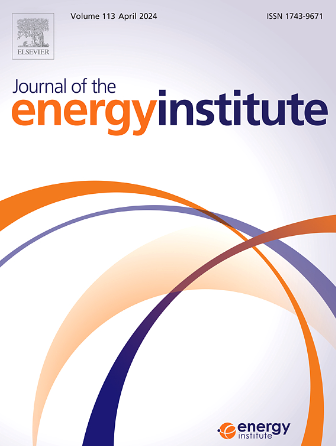AAEMs对煤密度分离馏分热解的影响机理:基于热重分析、原位拉曼光谱和原位EPR技术的结合研究
IF 5.6
2区 工程技术
Q2 ENERGY & FUELS
引用次数: 0
摘要
本研究采用原位拉曼和原位电子顺磁共振(EPR)光谱结合热重分析(TGA)技术,研究了碱和碱土金属物质(aaem)对典型富aaem煤准东煤(<1.40 g/cm3、1.40 - 1.45 g/cm3、1.45-1.50 g/cm3和>;1.50 g/cm3等密度分离组分热解演化的影响。准东煤中固有的aaem主要以Na和Ca的形式存在。从aaem的赋存特征来看,离子交换aaem的相对含量在密度分离馏分之间较为接近,水溶性和盐酸溶性aaem主要存在于1.50 g/cm3馏分中。热解失重率和最大失重速率(Rmax)随馏分密度的增大而减小。密度分离馏分中aaem的化学结构和赋存特征对其热解特性有共同影响。在热解脱挥发阶段,水溶性AAEMs促进了活性组分的释放,加速了AAEMs与焦炭基体之间形成更稳定的键,抑制了焦炭中1-2个芳环的释放,特别是在1.40 g/cm3馏分中。这一阶段促进了交联结构和3-5个芳环的形成,特别是在1.50 g/cm3馏分,以及1.40 g/cm3馏分自由基的偶联。在芳构化聚合阶段,水溶性Na/K的影响是明显的,特别是对于<;1.40 g/cm3馏分。二价AAEMs均能抑制芳烃环的缩聚,提高稳定自由基的反应活性,其中水溶性AAEMs在1.50 g/cm3馏分中表现得尤为明显。发现并建立了热解反应活性与原位化学结构之间的良好相关性。期望在综合梯级的基础上指导煤炭利用。本文章由计算机程序翻译,如有差异,请以英文原文为准。
Influence mechanism of AAEMs on the pyrolysis of coal density-separated fractions: Insights from combining TGA, in-situ Raman spectroscopy and in-situ EPR technique
In this study, in-situ Raman and in-situ Electron Paramagnetic Resonance (EPR) spectroscopy combining thermogravimetric analysis (TGA) were developed to investigate the effects of alkali and alkaline earth metallic species (AAEMs) on the evolution of Zhundong coal (a typical AAEMs-rich coal) density-separated fractions including <1.40 g/cm3, 1.40–1.45 g/cm3, 1.45–1.50 g/cm3 and >1.50 g/cm3 during pyrolysis. The inherent AAEMs in the Zhundong coal mainly exist as Na and Ca. For occurrence characteristics of AAEMs, the relative amount of ion-exchangeable AAEMs is close between density-separated fractions, and the water-soluble and HCl-soluble AAEMs mainly exist in the >1.50 g/cm3 fraction. The pyrolysis weight loss and the maximum mass loss rate (Rmax) decrease with the increases of the fraction's density. The chemical structure and the occurrence characteristics of AAEMs of density-separated fractions have a combined effect on their pyrolysis characteristics. At the devolatilization stage of the pyrolysis, water-soluble AAEMs promote the release of active components, accelerate the formation of more stable bonds between AAEMs and char matrix and inhibit the release of the 1–2 aromatic rings in char especially for the <1.40 g/cm3 fraction. In this stage, the formation of the cross-linking structures and 3–5 aromatic rings especially for the >1.50 g/cm3 fraction, and the coupling of free radicals especially for the <1.40 g/cm3 fraction are promoted. At the aromatization polymerization stage, the effects of water-soluble Na/K are obvious, especially for the <1.40 g/cm3 fraction. The divalent AAEMs all can inhibit the condensation of aromatic rings and improve the reactivity of stable free radicals, especially for water-soluble divalent AAEMs in the >1.50 g/cm3 fraction. Good correlations between pyrolysis reactivity and in-situ chemical structure were found and established. It was expected to direct the coal utilization based on integrated cascade stages.
求助全文
通过发布文献求助,成功后即可免费获取论文全文。
去求助
来源期刊

Journal of The Energy Institute
工程技术-能源与燃料
CiteScore
10.60
自引率
5.30%
发文量
166
审稿时长
16 days
期刊介绍:
The Journal of the Energy Institute provides peer reviewed coverage of original high quality research on energy, engineering and technology.The coverage is broad and the main areas of interest include:
Combustion engineering and associated technologies; process heating; power generation; engines and propulsion; emissions and environmental pollution control; clean coal technologies; carbon abatement technologies
Emissions and environmental pollution control; safety and hazards;
Clean coal technologies; carbon abatement technologies, including carbon capture and storage, CCS;
Petroleum engineering and fuel quality, including storage and transport
Alternative energy sources; biomass utilisation and biomass conversion technologies; energy from waste, incineration and recycling
Energy conversion, energy recovery and energy efficiency; space heating, fuel cells, heat pumps and cooling systems
Energy storage
The journal''s coverage reflects changes in energy technology that result from the transition to more efficient energy production and end use together with reduced carbon emission.
 求助内容:
求助内容: 应助结果提醒方式:
应助结果提醒方式:


